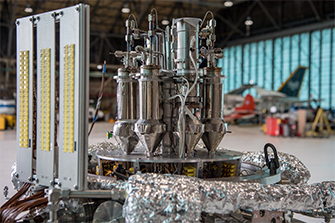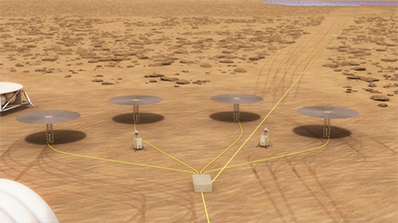NASA is pushing forward on testing a key energy source that could literally “empower” human crews on the Mars surface, energizing habitats and running on-the-spot processing equipment to transform Red Planet resources into oxygen, water and fuel.
The agency’s Space Technology Mission Directorate (STMD) has provided multi-year funding to the Kilopower project. Testing is due to start in November and go through early next year, with NASA partnering with the Department of Energy’s (DOE) Nevada National Security Site to appraise fission power technologies. The NNSS will serve as host for the experiments.
Confidence builder
“The Kilopower test program will give us confidence that this technology is ready for space flight development. We’ll be checking analytical models along the way for verification of how well the hardware is working,” explains Lee Mason, STMD’s principal technologist for Power and Energy Storage at NASA Headquarters.
The DOE/National Nuclear Security Administration infrastructure and expertise have been instrumental, Mason points out, as have the talents of Los Alamos National Laboratory engineers in New Mexico. NASA’s Glenn Research Center in Cleveland has managed all phases of the Kilopower Project, from designing and building the hardware, with contributions from NASA’s Marshall Space Flight Center in Huntsville, Alabama, through developing the test plan and operating the tests. The Y12 National Security Complex in Oak Ridge, Tennessee is providing the reactor core.

“A space nuclear reactor could provide a high energy density power source with the ability to operate independent of solar energy or orientation, and the ability to operate in extremely harsh environments, such as the Martian surface,” notes Patrick McClure, project lead on the Kilopower work at the Los Alamos National Laboratory.
“The reactor technology we are testing could be applicable to multiple NASA missions, and we ultimately hope that this is the first step for fission reactors to create a new paradigm of truly ambitious and inspiring space exploration,” adds David Poston, Los Alamos’ chief reactor designer. “Simplicity is essential to any first-of-a-kind engineering project – not necessarily the simplest design, but finding the simplest path through design, development, fabrication, safety and testing.”
Sun-independent power
The pioneering Kilopower reactor represents a small and simple approach for long-duration, sun-independent electric power for space or extraterrestrial surfaces.
Offering prolonged life and reliability, such technology could produce from one to 10 kilowatts of electrical power, continuously for 10 years or more, Mason points out. (The average U.S. household runs on about five kilowatts of power). The prototype power system uses a solid, cast uranium-235 reactor core, about the size of a paper towel roll. Reactor heat is transferred via passive sodium heat pipes, with that heat then converted to electricity by high-efficiency Stirling engines. A Stirling engine uses heat to create pressure forces that move a piston, which is coupled to an alternator to produce electricity, similar in some respects to an automobile engine.
Having a space-rated fission power unit for Mars explorers would be a game changer, Mason adds. No worries about meeting power demands during the night or long, sunlight-reducing dust storms. “It solves those issues and provides a constant supply of power regardless of where you are located on Mars. Fission power could expand the possible landing sites on Mars to include the high northern latitudes, where ice may be present,” he points out.
Power options
NASA has flown a number of missions powered by radioisotope thermoelectric generators (RTGs) over the past five decades, such as onboard the two Viking Mars landers, the Curiosity rover now at work on the Red Planet, the Apollo expeditions to the moon, the two Voyager spacecraft, and the New Horizons probe to Pluto and beyond, as well as the just-concluded Cassini mission at Saturn. RTGs produce electricity passively with no moving parts, using the heat from the natural decay of their radioisotope heat source.
“What we are striving to do is give space missions an option beyond RTGs, which generally provide a couple hundred watts or so,” Mason says. “The big difference between all the great things we’ve done on Mars, and what we would need to do for a human mission to that planet, is power. This new technology could provide kilowatts and can eventually be evolved to provide hundreds of kilowatts, or even megawatts of power. We call it the Kilopower project because it gives us a near-term option to provide kilowatts for missions that previously were constrained to use less. But first things first, and our test program is the way to get started.”
The novel energy-providing technology also makes possible a modular option for human exploration of Mars. Small enough in size, multiple units could be delivered on a single Mars lander and operated independently for human surface missions.
Breadboard test
In step-wise fashion, with safety as a guiding principle, Mason says the Kilopower hardware will undergo a full-power test lasting some 28 hours.
Moving the power system from ground-testing into a space system is an achievable objective, says Don Palac, Kilopower project manager.
Lead Researcher Marc Gibson adds, “The upcoming Nevada testing will answer a lot of technical questions to prove out the feasibility of this technology, with the goal of moving it to a Technology Readiness Level of 5. It’s a breadboard test in a vacuum environment, operating the equipment at the relevant conditions.”
Looking into the future, Mason suggests that the technology would be ideal for furthering lunar exploration objectives too. “The technology doesn’t care. Moon and or Mars, this power system is agnostic to those environments.”

